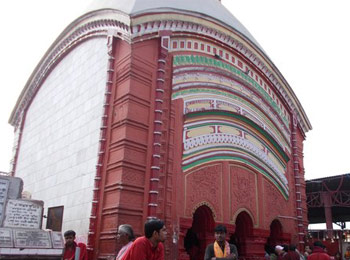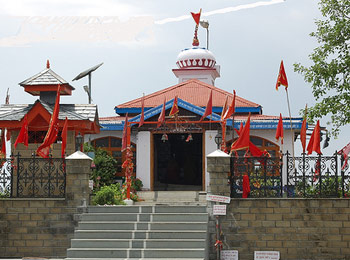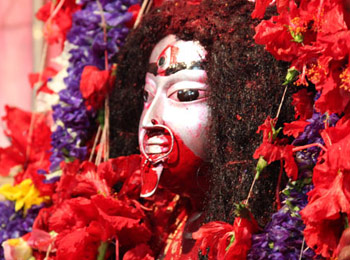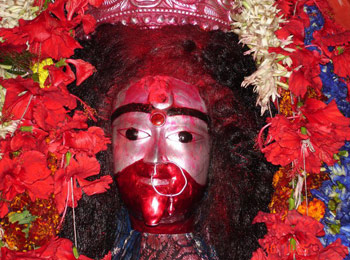- Kali
Tarapith Temple
- Tarapith,West Bengal
- View on map
- Tell us about this temple
Overview
The Tara temple in Tarapith steeped in the narrated myths is a medium sized temple in the rural precincts of Bengal. Its fame as a pilgrimage centre with the deity of Tara enshrined in it is due to "the temple’s founding myths, its type of worship (which includes blood offerings), the hymns sung there, the powers of the nearby tank, and the inhabitants and rituals of the adjacent cremation ground".
The temple base is thick with thick walls, built of red brick. The superstructure has covered passages with many arches rising to the pinnacle with a spire (shikara). The image of the deity is enshrined under the eaves in the sanctum. There are two Tara images in the sanctum.The stone image of Tara depicted as a mother suckling Shiva – the "primordial image" (seen in the inset of the fierce form of the image of Tara) is camouflaged by a three feet metal image, that the devotee normally seen. It represents Tara in her fiery form with four arms, wearing a garland of skulls and a protruding tongue. Crowned with a silver crown and with flowing hair, the outer image wrapped in a sari and decked in marigold garlands with a silver umbrella over its head. The forehead of the metal image is adorned with red kumkum (vermilion). Priests take a speck of this kumkum and apply it on the foreheads of the devotees as a mark of Tara's blessings. The devotees offer coconuts, bananas and silk saris, and unusually bottles of whisky. The primordial image of Tara has been described as a "dramatic Hindu image of Tara’s gentler aspect".
The priests of the temple offer puja (worship) with great reverence to bring out her motherly aspect to the devotees, blending the North Indian fierce depiction of the Sati myth of the goddess with the peaceful motherly visionary form of Tara seen by Buddha and his disciple Vasishtha of the Tantric tradition – the Buddhist Tara form. At Tarapith, though the softer motherly aspect of the fierce goddess is emphasized. Chanting hymns or poems in her praise is also a part of the devotional appeal made to the goddess.
The devotees take a holy bath at the sacred tank adjacent to the temple before entering the temple premises to offer worship and even after the worship. The waters of the tank are said to have healing powers and even restore life to the dead.
Blood sacrifice of goats is the daily norm in the temple. Devotees who offer such goat sacrifices seek blessings from the deity. They bathe the goats in the holy tank near the temple before the sacrifice. They also purify themselves by taking bath in the holy tank before offering worship to the deity. The goat is then tethered to a stake, the designated post in a sand pit, and the neck of the goat butchered with a single stroke by a special sword. A small quantity of the blood of the goat is then collected in a vessel and offered to the deity in the temple. The devotees also smear their forehead with a bit of blood from the pit, as a mark of reverence to the deity.
About The Temple

Some 264 km from Kolkata, Tarapith is situated on the banks of the north flowing Dwarka River, in Birbhum, in West Bengal.Tara Maa of Tarapith, another form of Kali, has two hands, is garlanded with snakes, is adorned in sacred threads, and has Shiva lying in her left lap sucking her breast. But the temple is dedicated to the destructive aspect of Shiva, which takes the form of Kali. She requires sacrifice daily to satisfy her blood lust so every morning goats are sacrifices on the alter of the temple.
The temple is busy through out the year and is surrounded by poor who come to have free meal. This is one of the most sacred places where every year several millions of devotees come to offer Puja. Tarapith is regarded as Mahapeeth and extremely holy place for all Hindus. It is said that wherever you are in this beautiful world, whatever be you and your religion, the kindness and blessings of Maa Tara will reach you to fulfill your desires, if you are an honest and upright person. She will provide you relief from pain if any your heart and mind. This is the reason for which every year millions of devotees gathers at this place to offer Puja and prayer.
About The Deity

The idol of Ma Tara is spectacular to behold. Her mask is made of silver and its finely-crafted face is graced with three eyes. These eyes look northward except during an annual festival when the entire murti is placed in a nearby “resting temple” located near the main mandir. On this special occasion only, Ma Tara faces west, overlooking the cremation ground. The murti’s mouth is smeared with red sindoor (vermilion) paste in a manner resembling blood, and she has a long protruding tongue. Her tongue is also covered in red pigment, but at its tip, silver is exposed as the sindoor gets worn away from the many offerings of whiskey fed to Tara on a daily basis. Priests pour the liquor into a small vessel which is then offered to the goddess by holding it up to immerse her tongue. A mixture of liquor, water, and sindoor that has been offered to the goddess is considered especially sacred.
Ara Ma’s murti also has a luxurious mane of matted locks made from what feels like human hair. Atop this rests a very large, ornate crown adorned with a five-petalled hibiscus flower as well as a pentagram. Judging by various calendar art prints and photos of the murti, this crown has undergone various alterations as it is periodically crafted anew by artisans. Despite these changes, the motif of a star persists. The star symbolism is most likely an allusion to the name “Tara,” which in Sanskrit means “star.”
Although this representation of the goddess is certainly the most renowned, concealed within it is the far more ancient adi rup the original stone form of the goddess Tara that has been worshiped at Tarapith for countless centuries. According to some myths surrounding Tarapith, this particular rock formation is the goddess Sati’s third eye which fell to the earth ages ago and landed in the cremation ground where it turned to stone. The adi rup’s shape is said to reveal the goddess in her maternal aspect, cradling and suckling Lord Shiva like a baby.
Tara Maa has Four Incarnations these are:
- Tara (also worshipped as Goddess of wealth-Lakshmi)
- Ugro Tara
- Maha Ugro Tara
- Neel Saraswati (also worshipped as Goddess of Knowledge who safeguards against water accidents)
Maa Tara is one of Dus (Ten) Mahavidyas of Maa Shakti. She is also the Guru of Brihaspati (Jupiter) who in turn is the Guru of all the nine planets.
Legend and Stories

Amrit Manthan was made with the objective of churning out AMRIT from the ocean.The Devas and Asuras took part in this churning exercise together. Amrit is the holy nectar which offers immortality to anybody who drinks it. Both the Devas and the Asuras wanted to have it. However, it is not the only thing that came out of the water. Many invaluable gems and stones and medicines were also yielded by the ocean. Likewise the ocean also yielded poison . The poison was so strong that if it fell on the ground then all Life would be wiped out. Fearing such devastation the Asuras and Devas went to Lord Shiva for help. He promised that He would drink the poison and save the world from destruction. As He drank the poison He was filled with pain. His body started burning from inside. When the pain became unbearable Maa Tara came and She fed Shiva her milk and He was cured.
When Sati Maa could not tolerate the taunts and insults made by her father Daksha against her husband Lord Shiva, She immersed Herself in fire. As He received the shocking news, an angered Lord Shiva broke into a Dance carrying the body of His beloved wife on his shoulder. The world shook from fear of destruction.
Fearing that the whole world would come to an end, the Devas went to Lord Vishnu to somehow stop Lord Shiva from destroying the world. Lord Vishnu cut the body of Sati Maa into 108 pieces with His Sudarshan Chakra. With the body gone which was the source of grief, Lord Shiva regained His composure and the world was saved.
It is believed that some parts of the body fell in the ocean and some on land covering the whole of the Indian subcontinent. The places where the parts of the body fell have become holy places and are known as Shakti Pithas, where Mother is worshiped in her different Incarnations. There are 51 Shaktipithas in all so far, there may be more. Maa Tara is one of Shakti's Incarnation. It is believed that she is the third eye of Maa Shakti. Tarapith is where Maa Tara is worshipped.
We first come to know of Tarapith from Brahmrishi Vashistdev. Brahmrishi Vashistdev wished to receive Siddhi from Tara Maa, for this he had to do Sadhana, but after years of Sadhana he could not earn Siddhi. Then one day he heard a devya vani from the skies. It asked him to visit Buddharupi Janardhan in Mahachin.
On meeting Buddharupi Janardhan, Vashistdev was asked to meditate on the banks of river Dwarka in Birbhum district of what is now called West Bengal. On doing so Vashistdev received Siddhi from Tara Maa.
Years later Jayadatta a rich trader was travelling by river on his boat with his family. After travelling for some time Jayadatta decided to rest as he came across this place. As they camped there, his son was bitten by a poisonous snake and he died instantly. Having lost his son Jayadatta wandered about aimlessly in great sorrow. He came across a place where he saw a fisherman trying to wash cut pieces of a fish with water from a nearby pond. As the fisherman sprinkled water on the dead fish, the pieces joined together and the fish regained life and jumped back in the pond. On seeing this miracle Jayadatta decided to put the same magic water on his dead son. On doing so his son also regained life.Jayadatta realized this was a miracle pond in a very special place. He could feel the power all around. He handed the business over to his son, retired from the materialistic world and went into Sadhana.
In recent times this holy place which is now known as Tarapith was made famous by His Holiness Bamakhyapa. Bamakhyapa was a very powerful Sadhak of Maa Tara, whose life totally revolved around Maa. There are many Miracle stories involving Bamakhyapa and Maa Tara. He was a chosen and beloved son of Maa. It is largely because of Bamakhyapa that we know of Tarapith.Bamakhyapa used to worship Neel Tara.There is an actual photograph of an oil painting of Neel Tara which was worshipped by Bamakhyapa. It is said that the oil painting was painted in early 1900. The said information was given by Shri Soumendra Bhattacharya of Rampurhat.
Arti / Pooja / seva
The Tara Devi Mantra is Hreem Shreem Hoom Phat, Om Hreem Shreem Hoom Phat, Shreem Hreem Shreem Hoom Phat. The Puja includes Kalash Sthapana, Panchang Sthapana(Gauri Ganesh, Punyavachan, Shodash Matrika, Navgraha, Sarvotabhadra), 64 yogini Pujan, Shetrapal Pujan, Swasti Vachan, Sankalpa, Ganesh Pujan and Abhishek, Navgraha Pujan and 108 chants of each planetary mantra, Invocation of major Gods and Goddesses in Kalash, Brahman Varn, Abhishek and Puja of Idol of Tara Devi, Tara Devi Yantra Puja, Tara Devi Mantra Japa, Tara Devi Kavach recitation, Tara Devi Yajna, Aarti and Pushpaanjali.
Prasad and offerings
Normally she is satisfied with Milk made Peda (a kind of sweet made with milk), But, her favorite items for eating is, "madhu-mishrit-anya" or honey mixed pulao or rice, All types of fish but specially "Sole and Rahu Fish", Meat of Goat (chag), every type of wine and alcohol (Indian or English), Ganja (Cannabis) and Tobacco for smoke, food prepared with the head of the Fish.
Java Kusum (China Rose) or Java or Gurhal, Aprajita or Nilkanth (Butterfly-Pea), Lotus or Padma or Kamal, Kaner or Oleander, Bilva-Patra (Wood apple tree leafs), these flower are very dear to Goddess Ugra Tara. Garland of these flowers are easily available near to Temple. A garland of the above flowers, especially Rudraksha-Garland, a type of seed which is highly suspicious and significant in Hinduism because of, which consider as the tear of Rudra (anger form of lord Shiva), Lemon Garland, Garland of raw lump of Turmeric, Garland of bones of human beings and as well as animals, Garland of human skull (not for everyone, followers of Tantric rituals).
Rare Facts
Legend has it that Tara Maa provides Moksha to devotees regardless of their Karma if they get her blessings. Tara Maa is present everywhere in the universe and is known as Brahmamayi Tara. One should say Jay Jay Tara with the true belief all his problems get solved.
Significance
People approach this temple for immense abundance in all spheres of life, for peace and protection, for compassion, serenity, wisdom and knowledge and for divine grace and blessings of Maa Tara Devi.
Accessibility
This temple is situated in Tarapur Village in Rampurhat block of Birbhum District in West Bengal, India.
Airport
The nearest Airport is Kolkata.
Railways
The best way is to reach here is through Rampurhat Railway Station, which is approximately 220 Km from Sealdah or Howrah Railway Station in Kolkata, the capital of West Bengal and also one of the Metros of India.From Rampurhat Railway Station, one has to make a journey by different road transports like Autos, Buses, Cabs, and so on, which are available 24 hours from Rampurhat Railway Station.Tarapith temple is at a distance of 7 Km from Rampurhat Railway Station. Another route to come here is via Barddhaman Railway Station, 120km from this place.
Road
This place is also well connected with different cities of West Bengal by road network. State Highway no. 13 is the nearest Highway to this temple.Rampurhat also lies close to Bolpur (Shantiniketan, famous for Vishvabharati University, and home to Rabindra Nath Tagore), Barddhaman, Malda towns in West Bengal. All these places are well connected with Rampurhat by rail and road network.
Temple Address
Tarapith Temple,
P.O.-Tarapith(chandipur),Birbhum Dist.,
West Bengal,India,Pin-731233.
Significance
Devotees visit this temple to seek fulfillment of the following:-
- Protection from evil
- Salvation
- Destruction of ego
- Liberation
Shlokas
Jayantii Manggalaa Kaalii Bhadrakaalii Kapaalinii Durgaa Shivaa Kssamaa Dhaatrii Svaahaa Svadhaa Namostu Te
Meaning -We salute the Devi Kali, who is always victorious and always auspicious, we offer salutations to Bhadrakali Devi who wears a skull garland, we salute Shiva's consort and the embodiment of self-control and supports all beings, Devi Durga, who is Swaha as well as Swadha. We offer our salutations to you.
Om Maha Kalyai Ca Vidmahe Smasana Vasinyai Ca Dhimahi Tanno Kali Prachodayat
Meaning -Om the great Goddess Kali who stays in the ocean of life and burial grounds, we focus our energies on you, may you grant us our wishes and bless us
Kaalika Kalahey Gorey Paathuthvaam Parameshwari Mandapey Thathra Mathangi Thatha Sowmya Swayamwarey
Meaning -Let the ever charming, mother of the universe, protect us and stay in this mandap and bestow her blessing on us as mother Mathangi.
Katyayani Mahamaye Mahayoginyadheeshwari Nandgopsutam Devipatim Me Kuru Te Namah
Meaning -Oh Goddess Katyayani, the great vigour of the Lord, the owner of great magical power and the mighty one who controls all, please make the son of Nanda Maharaj my husband. I offer my salutations to you.
